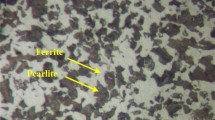Abstract
The main purpose of this work is to study the influence of copper content on Al–Si–Mg aluminum alloy’s (6351) machinability. This alloy’s machinability was evaluated through cutting tool torque and thrust force measurements, holes’ surface roughness, diameter, roundness, cylindricity and subsurface modifications during the reaming process. The Al–Si–Mg alloy samples were produced with five levels of copper (0.07%, 0.23%, 0.94%, 1.43% and 1.93%) and have a chemical composition of the other alloying elements practically constant within the recommended range by the Aluminum Association for this alloy. The main mechanical properties of the 6351 aluminum alloy samples were obtained by microstructural analysis and microhardness, hardness and tensile tests. Major amounts of copper resulted in a significant increase in microhardness, hardness and ultimate tensile strength of the aluminum alloy, while elongation after fracture decreased. A 23 factorial design was used to verify the effect of copper content and cutting parameters cutting speed and feed rate in machinability responses. Furthermore, it was developed an adjusted model to optimize the cutting parameters selection to machine the alloy with the best copper content for each response parameter of the reaming process. The results showed a significant influence of copper content in this aluminum alloy’s machinability. Lower values of torque and thrust forces, better surface finish, lower roundness and cylindricity deviation were obtained increasing copper content in Al–Si–Mg aluminum alloy (6351).


















Similar content being viewed by others
References
International Aluminium Institute, World Aluminium (2016). www.world-aluminium.org. Accessed May 30, 2016
ASM International (1990) Metals handbook. Properties and selection: nonferrous alloys and special-purpose materials, vol 2, 10th edn. ASM International, Novelty, USA
Totten GE, MacKenzie DS (eds) (2003) Physical metallurgy and the effect of alloying additions in aluminum alloys. In: Handbook of aluminum, vol 1. Physical metallurgy and process, pp 81–209. https://doi.org/10.1201/9780203912607
Li YJ, Brusethaug S, Olsen A (2006) Influence of Cu on the mechanical properties and precipitation behavior of AlSi7Mg0.5 alloy during aging treatment. Scr Mater 54:99–103. https://doi.org/10.1016/j.scriptamat.2005.08.044
Ding L, Jia Z, Zhang Z, Sanders RE, Liu Q, Yang G (2015) The natural aging and precipitation hardening behaviour of Al–Mg–Si–Cu alloys with different Mg/Si ratios and Cu additions. Mater Sci Eng A 627:119–126. https://doi.org/10.1016/j.msea.2014.12.086
Zheng Y, Xiao W, Ge S, Zhao W, Hanada S, Ma C (2015) Effects of Cu content and Cu/Mg ratio on the microstructure and mechanical properties of Al–Si–Cu–Mg alloys. J Alloys Compd 649:291–296. https://doi.org/10.1016/j.jallcom.2015.07.090
Sunde JK, Marioara CD, van Helvoort ATJ, Holmestad R (2018) The evolution of precipitate crystal structures in an Al–Mg–Si(–Cu) alloy studied by a combined HAADF-STEM and SPED approach. Mater Charact 142:458–469. https://doi.org/10.1016/j.matchar.2018.05.031
Han Y, Samuel AM, Doty HW, Valtierra S, Samuel FH (2014) Optimizing the tensile properties of Al–Si–Cu–Mg 319-type alloys: Role of solution heat treatment. Mater. Des. 58:426–438. https://doi.org/10.1016/j.matdes.2014.01.060
Froehlich AR, Jacques RC, Strohaecker TR, Mombru R (2007) The correlation of machinability and microstructural characteristics of different extruded aluminum alloys. J Mater Eng Perform 16:784–791. https://doi.org/10.1007/s11665-007-9097-0
Zedan Y, Alkahtani S (2013) Influence of the microstructure on the machinability of heat-treated Al–10.8% Si cast alloys: role of copper-rich intermetallics. J Mater Process Technol 213:167–179. https://doi.org/10.1016/j.jmatprotec.2012.09.007
ASM International (1990) Metals handbook vol 16: machining, 10th edn. ASM International, Novelty, USA
Bezerra AA, Machado AR, Souza AM, Ezugwu EO (2001) Effects of machining parameters when reaming aluminium-silicon (SAE 322) alloy. J Mater Process Technol 112:185–198. https://doi.org/10.1016/S0924-0136(01)00561-1
The Aluminum Association (2015) International alloy designation and chemical composition limits for wrought aluminum and wrought aluminum alloys. The Aluminum Association, Arlington, VA, p 10
Shabestari SG, Moemeni H (2004) Effect of copper and solidification conditions on the microstructure and mechanical properties of Al–Si–Mg alloys. J Mater Process Technol 153–154:193–198. https://doi.org/10.1016/j.jmatprotec.2004.04.302
Wang G, Sun Q, Feng L, Hui L, Jing C (2007) Influence of Cu content on ageing behavior of AlSiMgCu cast alloys. Mater Des 28:1001–1005. https://doi.org/10.1016/j.matdes.2005.11.015
Zeren M, Karakulak E, GÜmÜs S (2011) Influence of Cu addition on microstructure and hardness of near-eutectic Al–Si–xCu–alloys. Trans Nonferrous Met Soc China 21:1698–1702. https://doi.org/10.1016/s1003-6326(11)60917-5
Lu T, Wu J, Pan Y, Tao S, Chen Y (2015) Optimizing the tensile properties of Al–11Si–0.3 Mg alloys: Role of Cu addition. J Alloys Compd 631:276–282. https://doi.org/10.1016/j.jallcom.2015.01.107
Yamada Y (2010) Melhoria da Produtividade na obtenção de Furos em Liga de Alumínio Aeronáutico com Ferramentas de Aço Rápido, Universidade Estadual de Campinas
de VA, Rosa O (2012) Investigação da Operação de Alargamento dos Furos Usinados em Pistões de Ferro-Carbono Sinterizado, Universidade Federal de Uberlândia
Machado ÁR, Abrão AM, Coelho RT, Da Silva MB (2011) Teoria da Usinagem dos Materiais, 2nd edn. Blucher, São Paulo
Gabor H (1982) Como atuam os alargadores, Rev Máquinas E Met. Máquinas e Metais XVIII(205):16–21
Bhowmick S, Lukitsch MJ, Alpas AT (2010) Tapping of Al-Si alloys with diamond-like carbon coated tools and minimum quantity lubrication. J Mater Process Technol 210:2142–2153. https://doi.org/10.1016/j.jmatprotec.2010.07.032
Acknowledgments
The authors would like to thank CBA (Brazilian Aluminum Company) for aluminum alloys specimens, LEPU (Laboratory for Teaching and Researching in Machining), Mechanical Engineering Department of Federal University of Uberlândia (UFU) and Science and Technology Institute (ICT) of Federal University of Valleys of Jequitinhonha e Mucuri (UFVJM).
Author information
Authors and Affiliations
Corresponding author
Additional information
Technical Editor: Márcio Bacci da Silva, Ph.D.
Rights and permissions
About this article
Cite this article
Gonçalves, R.A., da Silva, M.B. & Costa, É.S. Statistical analysis of cutting forces and hole accuracy in reaming an Al–Si–Mg alloy (6351) with different copper contents. J Braz. Soc. Mech. Sci. Eng. 40, 544 (2018). https://doi.org/10.1007/s40430-018-1450-8
Received:
Accepted:
Published:
DOI: https://doi.org/10.1007/s40430-018-1450-8



